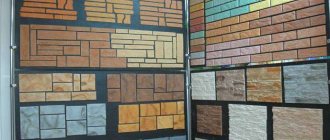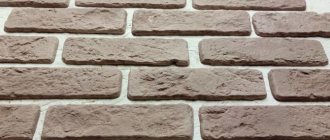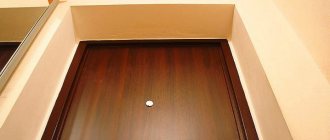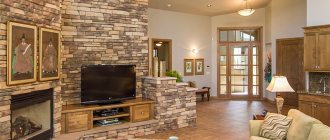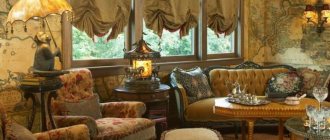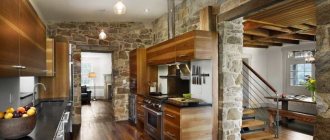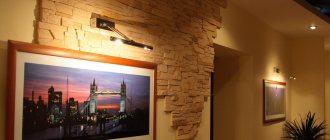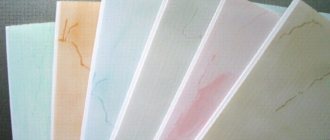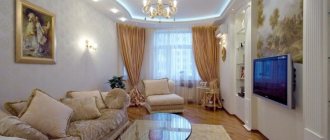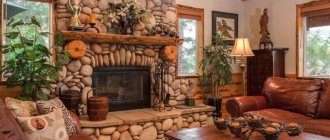Home improvement is a projection of mentality, internal worldview. This is a desire to reflect your idea of aesthetics and comfort. Many people use ready-made ideas, but you can find suitable materials to implement your own design concept. Experts have developed rules for decorative stone finishing in interior spaces. It is important to know about them for those who intend to use stone for the first time in the interior of an apartment. Natural materials fit perfectly into most styles, but if rough texture is used incorrectly, it is difficult to create an atmosphere of warmth and comfort.
The right decision would be to decorate the living room walls with decorative stone
Decorative stone in the interior of the living room
White decorative stone perfectly complements the bedroom interior
Types of natural stone for finishing and their advantages
Natural stone is quite capricious to work with, but at the same time this material has a unique texture and color, is durable and stable, environmentally friendly and especially luxurious.
It is difficult to imagine many interiors without such a stylistic solution.
There are several types of natural stone popular for interior decoration:
- marble is distinguished by its variety of colors, durability and high price;
- granite is easy to maintain and resistant to mechanical damage;
- travertine is resistant to moisture and is popular for decorating bathrooms;
- limestone is available in a wide variety of colors, is easy to work, quite inexpensive, but also very fragile;
- shell rock is characterized by the presence of a porous structure, is fragile, and requires additional coating with special materials;
- tuff has high thermal insulation properties, is easy to saw, and is not resistant to moisture.
To make the interior of a room with stone harmonious, it must be diluted with softer materials. This could be decorative plaster, wallpaper, painted walls, etc.
A large number of rough surfaces in a room can create an undesirable effect and make the atmosphere cold and uncomfortable.
Small forms using decorative stone
Flowing water adds a special zest to the interior of a relaxation space: light murmuring sounds soothe, set one in a creative mood, harmonize a person’s inner state of mind, and the smallest water vapor moisturizes dry air. Therefore, installing a home fountain can not only decorate the room, but also improve the health of the inhabitants.
When decorating a wall with a fountain with artificial stone, it is necessary to complement the structure with a glass vertical surface along which streams of water will flow.
A transparent barrier is not visible visually, but it is easier to keep it clean because Lime streaks form on the stone surface from prolonged contact with water. Glass will protect the masonry from moisture, prevent destruction of the structure, but the overall appearance will not be affected - the house will have a real, not an artificial, waterfall.
How to use in the interior
I want to share with you a few tips on using decorative stone for interior decoration:
- basic, unifying the entire style of an apartment or house, lining window and door openings. Here you can choose imitation brick, which fits perfectly into any style;
- An excellent backdrop for a large TV in the living room will be decorating part of the wall. If the room has a fireplace, then it can be lined with this material. This is a win-win option that carries a powerful stylistic load;
- Flemish brick imitation is suitable for decorating any room, allowing you to create a special atmosphere in the room;
- material with a rocky surface goes well with various pieces of decoration, plaster, wallpaper and painted walls;
- The kitchen apron can be lined with stone, creating a continuous space and a very stylish interior. In this case, it must be varnished to facilitate daily cleaning and emphasize the structure of the selected material.
Stone in different interior styles
The choice of decorative stone is so diverse that it can be used in any design, from Provence to high-tech. Let's consider how to choose a decorative stone for a specific interior style in order to emphasize its features and advantages.
Country
Styles that refer us to the interiors of cozy country houses (country, Provence, shabby chic, chalet) are difficult to imagine without finishing with natural stone. In older homes, stonework on the walls is often retained or exposed, paying tribute to the history of the home. Something similar can be recreated in an apartment by lining a wall or a fragment of it with voluminous slabs or cobblestones imitating wild stone.
Decorating a fireplace with wild stone in a country interior
Decorative stone tiles in a rustic style on a kitchen backsplash will bring a special rustic charm to the room. The warm shades and rough texture of natural dolomite, travertine, sandstone or their man-made analogues are suitable for finishing the floor in a country-style dining room, living room or bathroom.
Natural stone emphasizes the country style in the bathroom
Whitewashed brickwork, with the effect of slight negligence, is also often found in Provencal interiors. Stone can decorate not only walls and floors, but also a fireplace or an improvised hearth.
The fireplace is finished with natural stone tiles
The chalet style is characterized by a combination of massive wooden furniture, open ceiling beams, leather and fur with large stones on the walls and floor. It’s hard to imagine such an environment without a hearth with relief stonework.
Luxurious chalet style living room with stone walls
A country-style interior is always filled with homely warmth and natural aesthetics; glossy stone textures will be inappropriate; it is better to give preference to matte, rough surfaces.
Loft
Loft-style interiors have confidently migrated from public spaces to residential premises. Industrial aesthetics, metal structures, exposed pipes should be combined with raw, rough stone.
Kitchen-living room in loft style
Too glossy and elegant textures are alien to the loft. Choose concrete slabs; they may have scuffs and stains, even impromptu stains of paint or rust.
Advantages and disadvantages of finishing stone walls inside an apartment
Finishing with decorative stone in an apartment has its pros and cons. The positive aspects include:
- resistance to mechanical stress;
- combination of price and quality;
- the ability to complete the work independently in a short period of time;
- the absence of harmful additives and reagents in the composition of artificial stone and the environmental safety of natural stones;
- resistance to humidity and water ingress.
Among the shortcomings the following points stand out:
- the material is more expensive than conventional wallpaper;
- heavy weight and complex installation of a natural product;
- the need for treatment with disinfectants;
- Some varieties are poorly susceptible to restoration.
Decorating a balcony (loggia) with decorative stone
Decorating a balcony (loggia) with decorative stone is an excellent option for visually enlarging a small loggia area. Decorative stone on the balcony creates a feeling of warmth, naturalness and closeness to nature.
Due to its technical characteristics, artificial stone is perfect for laying on a balcony and also:
- It is inexpensive compared to other finishing materials.
- Easily withstands various minor impacts.
- Resistant to low and high temperature changes.
- Very durable and, importantly, environmentally friendly.
- Simply cut and adjusted to fit any size and shape of balconies.
Finishing a balcony with decorative artificial stone, photos of variations of which are below, is not a complex technological process, but rather the opposite - all installation work can be done step by step on your own. You just need to choose the design you like and put in a little effort.
Of course, you can also use the services of professionals who will do all the work for you, turnkey. We have already talked about turnkey repair and finishing of balconies, and much more, in the article - repair of balconies and loggias - photos of ready-made options and ideas for finishing, I advise you to study.
Next, we will discuss decorating entrance doors and openings with artificial stone.
Types of natural stone for finishing walls inside an apartment
Natural finishing material is used infrequently - it has a high price. But it also has its advantages: long service life, reliability, resistance to mechanical stress.
In addition, it retains heat well inside the apartment.
Marble
Strength and durability are two main characteristics of marble. There are many colors that are easy to match any design. It is resistant to temperature changes and tolerates moisture well. The stone can be polished, giving a beautiful appearance and shine.
The work process has its own nuances: heat treatment, grinding, polishing.
Slate
One of the most successful options for finishing work is an environmentally friendly and reliable material. You can choose different colors: green, black, red, gray tones. The use of such a stone is a sign of good taste among apartment owners.
A room decorated with slate looks elegant and unusual.
Wild
Wild stone is often used in the interior of an apartment. This is a unique material - the color and texture are not repeated, so the room looks unusual. It is used for finishing fireplaces, walls, columns.
Important! It is better to use the stone in doses, since your bedroom can turn into a primeval cave - it is characterized by natural roughness.
Granite
A good solution for any room - granite is moisture resistant, withstands sudden temperature changes, does not become dirty and does not wear off over time. There is a minus: background radiation, which is increased. To use it on a wall, it must be reinforced.
Granite is able to change colors when lighting changes; the edges shimmer in the sun.
Benefits of stone finishing
Like all existing design options, there are positive and negative aspects.
Pros:
- beautiful, looks expensive;
- durability, frost resistance;
- fire safety;
- strength, wear resistance;
- resistance to chemicals.
Minuses:
- gypsum is not suitable for wet rooms;
- natural is expensive.
Other finishing should match the type of stone - a heavy oak door looks great with granite, bricks can even be stuck above it - then the color of the ceiling also needs to be suitable. The lower parts of the walls are decorated most often.
Types of artificial stone for decorating walls inside an apartment
This type of stone creates the appearance of natural stone, which is why designers often use it. It is cheaper and easier to mount on the surface.
Concrete
This is a budget-friendly and simple finishing method that can be easily done with your own hands. The weight is light, which allows you to quickly finish the job. It can be made using sand, strength additives, dyes, and plasticizers.
This is a universal option that can be easily mounted on any surface.
Advice! Additives or plasticizers must be used - they increase structural strength and quality characteristics.
Acrylic
Decorating with acrylic stone has its advantages:
- light weight;
- no toxins;
- ease of installation - can be glued with special compounds;
- is not exposed to moisture, temperature, or mechanical damage.
This is a great option for any room.
Ceramic
This stone consists of red clay and granite chips, which are mixed and pressed under high temperatures. Thus, the finishing surface becomes shiny and glossy. This is a minus - the product can be easily scratched, it is practically not subject to restoration.
Disadvantages include heavy weight and difficulty of installation.
Most often it is used to decorate the walls of a building from the outside, rarely from the inside. Second option: stone-look ceramic tiles. This is a common material that can be purchased at any hardware store.
Plaster
It is made in this way: a liquid gypsum solution is poured into shaped molds and removed after complete drying. It is easy to work with and cut, its weight is almost 2 times less compared to concrete. Beautiful appearance and low cost are two factors for which gypsum stone has become a leader in the construction market.
Gypsum stone for interior decoration of an apartment is an excellent solution if it needs to be mounted on a plasterboard wall.
Quartz
This material is considered half artificial - the finished product contains almost 90% natural mineral. An ethereal synthetic resin acts as a binding base. Due to its excellent performance characteristics, quartz is used in the manufacture of countertops and sanitary ware.
Its cost is higher than that of acrylic analogues.
Decorative wall decoration in an apartment to look like stone
Decorative finishing of walls in an apartment with a stone look is a very inexpensive, but very effective way to create an individual image of a room.
High-quality stone wall finishing can be achieved through the use of the following materials:
- Decorative stone panels for interior decoration are fused elements that are ultimately fastened to the walls faster and easier.
- Decorative stone-look tiles take a little longer to install on the wall than panels, but unlike them, each tile has its own texture and looks more realistic.
- Decorative stone - it is a little heavier than tiles, as a result of which it needs to be fixed more securely.
Decorative wall decoration in an apartment with a stone look, photo variations of which are presented below, can bring some zest to your favorite rooms. What can I say - it’s better to see once than to hear 10 times! See and implement the options you like in your apartment.
It's time to discuss gypsum decorative stone in more detail, which we will do next.
Features of interior design with decorative tiles
Decorating interiors with decorative stone is a frequently used technique among designers. The materials have a number of advantages:
- aesthetic appeal;
- wide range of textures and colors;
- versatility, suitable for decorating different rooms;
- durability;
- ease of care;
- low cost.
Decorative stone in the interior is a stylish, practical, reliable decor.
Options for using artificial stone
Wall decoration with decorative stone is necessary in some interior designs, such as loft or country. There are ready-made templates that can be implemented indoors.
In the living room
The main room always has elements that can be framed with decorative stone finishing in the apartment. Most often, it is used in the following combinations:
- Fireplace. Decorative fireplaces are common in living rooms. They can be made from ordinary boxes and covered with putty. After this, it is enough to cover it with decorative bricks. It can be gypsum or flexible stone.
- The space behind the TV. It is often highlighted so that it is possible to create zoning of the wall. This is usually done with contrasting light. Therefore, the most convenient materials are: flexible brick, gypsum, porcelain stoneware, acrylic.
- A place to relax. When developing zoning, attention is often paid to the area behind the sofa, as in the photo. It should convey comfort and peace, so framing it with artificial brick is a popular design move.
In the bedroom
Finishing a bedroom with decorative brick is an opportunity to create a cozy design. Among them are:
The best ideas for decorating a champagne bottle for the New Year 2022 (50+ photos)- Ceramic tiles for the bathroom: tips for choosing and the best ideas for using modern tiles
- Unusual interior design - photos of current design innovations for 2022
- Colonial and neo-colonial style. Stone walls are the essential backdrop needed to recreate this warm, calm style. The best choice is regular gypsum stone, tinted with a desaturated yellow paint to achieve a sandstone tone.
- Loft. The interior of an industrial attic is impossible without exposed brick. To make the design authentic, you will need to resort to clinker, which perfectly imitates the old English block. Stones with grout and a lot of contrasting inclusions are suitable.
- Country. The style is similar to colonial, but wood should predominate here. Decorative stone cladding should act as a background on which multiple elements made of oak or ash will be placed.
In the bathroom and toilet
Traditionally, ceramic tiles are used in the bathroom.
But porcelain tiles are its best alternative, offering several amenities for this room:
- Durability. Tile is a very durable material, but if a shower head or metal ladle falls, it will crack. In this case, porcelain stoneware will help. He is not afraid of blows or falling.
- Lack of hygroscopicity. Other types of decorative stone, such as clinker or gypsum block, cannot remain in a humid environment for a long time. For this reason, they may crack and turn into dust. Porcelain tiles are not afraid of moisture, as they do not absorb it.
- Finishing corners. The slab is flat and easy to cut; it is possible to achieve a good joint, without visible irregularities and crooked seams.
In addition, it is possible to use acrylic blocks. This synthetic polymer has minimal hygroscopic qualities.
In the hall
This part of the house is a simple method of realizing imagination and design, as there are hundreds of schemes for decorating with decorative stone inside.
There are a few basic principles that can be applied:
- Door framing. A simple and interesting way to highlight a door from the overall decor. The stone needs to be placed along the contour, without a clear sequence, somewhat chaotically. Most often, a gypsum block is used, which is tinted to match the tone of the interior.
- Decorative stone on the wall should be placed in fragments. The reason for this is the infrastructure of the hallway. Here you need to place furniture, a place for shoes and outerwear, which will make a completely filled wall look alien. If the room is small, then gypsum stone will significantly narrow the room and make it uncomfortable.
- The choice of stone depends on the specifics of the design. The above design rules should be applied here as well; there is no need to deviate from the overall interior design and follow color combinations.
Features of living room decoration
The texture of natural stone creates comfort zones and brings the aura of the presence of a natural landscape into the interior. A designer's work with stone requires a balanced approach to the selection of textures and the amount of decor used.
Decorative stone in the interior of the living room is used:
- for decorating individual walls;
- highlighting transition zones in studio rooms;
- as accents for individual structural elements (shelves, niches);
- room zoning;
- flooring;
- for the fireplace and the area around it;
- as a frame for decorative panels and frescoes.
Most often, the central wall in the living room is highlighted with a decorative stone slab. Such a design solution not only serves as a method of aesthetic design, but also visually transforms the space.
Focus attention on the main element in the room where audio and video equipment and the fireplace area are located.
If the room has niches or plasterboard structures, then highlighting the texture of the stone will make them more expressive due to the aesthetic appeal and volume of the texture. Illumination will add additional color to such details.
Using stone decors with different textures is a good way to zoning a room.
For example, the flooring of the kitchen and dining area is laid with porcelain tiles of different shades. On the walls, the border part of the room is highlighted with a sandstone texture. Duplicate it on the central wall in the living room.
It is traditionally believed that the textures of marble, granite, and aventurine are more suitable for interiors in a classical style. But this is not entirely true. Glossy and matte smooth porcelain stoneware is an excellent decor in a minimalist interpretation of the living room.
A wall decorated with a marble slab will add a touch of stylish elegance to the interior.
Organic styles, country, Provence and others are primarily a combination of stone decor and wood.
Decorating the fireplace area with decorative stone is not only an aesthetic technique, but also a practical one. The slabs can withstand high temperatures, are easily cleaned of soot and deposits, and are not afraid of mechanical stress. The fireplace in the living room is one of the main compositional elements.
Flame, hearth and stone are the optimal solution for installing a fireplace area.
An artistic panel or fresco framed by decorative stones makes up a single ensemble. The decor is like a natural continuation of the natural landscape in the image.
Decorative stone finishing of doorways
Decorating doorways with decorative stone is a pretty cool solution for creating an extraordinary design.
Door openings decorated in this way attract the eyes of people looking at them like a magnet. The photos below of options for finishing doorways with decorative stone confirm this. Take a look for yourself.
Also, most people are increasingly resorting to framing the space around the front door with faux stone tiles.
This very framing can be done both inside the room and outside. The technical characteristics of the decorative stone do not contradict both options.
Decorating the front door with decorative stone (photos of options for which are given below) indoors, unfortunately, in most cases becomes noticeable only when leaving the home, because upon entering, guests rarely look back, but rather rush to enter the living room.
But believe me, when they get ready to leave, the front door, lined with decorative stone, will definitely not go unnoticed, and maybe even become an object of admiration and even envy.
It's time to consider options for finishing arches in an apartment with facing stone, which you can easily implement with your own hands.
Stone decor in the interior of the hallway
The hallway is a functional unit in an apartment or house. From it there are passages to other rooms, and at the same time it serves as a place for storing outerwear. The layout of the room is subordinated to functionality.
It is quite common to find long or rectangular small rooms with several doors.
The main goal of the hallway design is to transform the space of the room and visually expand it. The specialist is faced with the task of turning the hallway into part of the overall stylistic ensemble of the entire house or apartment.
Decorative stone in the hallway performs a double function, aesthetic and practical. On the one hand, this is a design decoration technique, on the other hand, stone tiles are a reliable protective coating that is easy to care for.
Decorative cladding in the interior
- The decor with artificial stone in the hallway becomes a kind of classic; it gives the interior a special charm, status and luxury. It is not afraid of temperature changes, so even freezing walls near the front door will not spoil the impression of the interior design, remaining the most practical option. In corridors and corners, “torn” or continuous cladding is used.
- Artificial stone in the living room is most often used on one wall, which is reserved for original decor. You can emphasize the beauty of upholstered furniture by covering the back of the sofa.
- A stone wall in the kitchen looks no less interesting than in other places in the apartment. Covering the apron of the stove with small pebbles or porcelain tiles imitating tiled marble is beautiful and practical.
- Masonry in a bathroom or toilet looks luxurious, regardless of texture. But for a classic interior, imitation marble is usually chosen.
- Imitation of natural texture is used less often in the bedroom; preference is given to light shades. It’s better when it’s one decorative wall, fireplace trim, niche or partition for zoning.
- In a children's room, a design with decorative stone is appropriate as an imitation of the masonry of a high tower from a fairy tale or a medieval princess's castle.
Stone can be used to cover different surfaces, but any decision must be justified by the design style. See more interesting ideas in the gallery of photo examples.
See also: Artificial stone in the interior of the hallway
Design solutions for decorating the hallway:
Transformation of space with the help of mirrors and a three-dimensional stone slab. This solution is suitable for narrow, long rooms. For example, a wardrobe with mirrored doors is placed opposite a wall with stone decor.
Stone tile decor in combination with wall frescoes, photo wallpaper or perspective images visually expands the room. To enhance the effect, you can hang a mirror on the opposite side.
A combined option is most often used for hallway lighting. For example, a stained glass window or a chandelier is in the main part of the hallway. Wall sconces are installed in the corridor leading to other rooms. Thanks to the voluminous texture and color palette of the stone decor, a visual transformation of the wall of a narrow passage room occurs.
To make the hallway aesthetically attractive, small niches and false columns are made on the wall. Decorative tiles and lighting will give them expressiveness.
Doorways are framed with stone decor for greater expressiveness.
Are there any disadvantages?
After such a solid portion of the obvious advantages of use, any disadvantages will seem completely insignificant. But they exist and, by and large, depend on the characteristics of a particular source material used for design.
- gypsum boards cannot be used in rooms with high levels of humidity - even accidental ingress of moisture can ruin their appearance, and among other things, prolonged exposure to high humidity conditions can cause cracks in the fragments and loss of performance properties;
- in some cases, imitation stone made from concrete or cement looks too conventional and careless, especially when it comes to cheap options - it is advisable to paint the material after finishing and apply a beautiful textured varnish as a finishing layer.
Otherwise, we have before us exactly the material that is convenient to work with, and which, upon installation, demonstrates an invariably pleasing result to the eye.
Stone in the interior of a balcony and loggia
The stone decor fits organically into the design of the balcony loggia. From a practical point of view, it is suitable for small areas. The walls do not get dirty and are easy to clean.
The slabs are not susceptible to changes in humidity.
To visually expand and transform the space, the same techniques are used as for hallways.
Relaxation areas and a mini-office are equipped on the loggias. If the area allows, you can make a dining area. In the case where a balcony or loggia is combined with a children's room, it is advisable to equip there a play area and a place for activities. The decor allows you to beautifully decorate a small space.
The panoramic view that opens from the loggia goes perfectly with the texture of the stonework.
Frequently used design solutions:
- framing an opening, passage;
- “torn” masonry;
- decor of one of the walls;
- decoration of structural elements with decorative stone.
A small room decorated with decorative stone with different textures, for example, brick and cobblestone, looks interesting.
Useful tips for finishing with stone
When decorating, it will be useful to apply the following rules:
- The laying of decorative stone should be combined with light (artificial or natural). This is especially true for rooms like the living room or bedroom. Light from the window should fall on the masonry, and at night it can be emphasized by lamps. This will create an accent and give the interior design authenticity.
- Natural plants are best combined with artificial stone. By decorating a room with large indoor plants, you can get a colorful combination.
- Loft and colonial style require a rough combination with glass and decorative lighting. This can be done with the help of Edison light bulbs, which barely shine, but create an atmosphere of relaxation and comfort. For connections, it is better to use durable, thick black wires to convey an authentic attic feel.
- If the room is small, it is better not to use thick panels, which will physically reduce the area. In this case, it is recommended to choose acrylic stone or porcelain stoneware. They do not narrow the space so much, but they provide the desired level of imitation.
Stone tiles in the nursery
Decorative stone in a nursery can become not only decoration, but also have a practical purpose. It is easily cleaned from contamination and is not afraid of rough mechanical impact. Stone tiles are laid on active impact zones: play areas, places for educational activities, sports areas.
For children's rooms, decorative slabs painted in bright, “cheerful” colors are used.
Teenagers gravitate towards urban, techno-style. These trends of minimalism attract textures such as brick.
Interior use options
If you have already decided what material you will use to imitate the stone texture, then it’s time to find a place for it in the interior. Where is finishing stone most often used inside an apartment?
Hallway
Always a winning solution, emphasizing the excellent taste of the owners. The slate rock looks great on the wall, favorably illuminated by spotlights: the desired volume is created, and if the stone is also varnished, you can get an excellent play with light.
Kitchen
Here it is best to use porcelain stoneware or flexible stone on the wall. The result will be equally beneficial, especially if you design the work area in this way. There are also frequent cases of using finishing stone to decorate a dining area. You can also use gypsum, but away from open sources of water and pre-treated with a primer.
Bedroom
In such an a priori calm and peaceful room, any stone texture on the wall fits without any problems. Refrain from dark rocks - they risk overloading the space and spoiling the atmosphere, but light slate, embanked dolomite or sandstone will add balance and organicity to the interior. By the way, you can choose an artificial stone in a neutral white color, and later paint it over with any suitable color.
Living room
A traditional place for active recreation for all family members. The use of finishing stone here allows you to emphasize the scale of the room and works great for the feeling of the overall nobility of the finish. There are frequent cases of similar design of walls in the area behind the TV.
or placed audio equipment - a winning option, especially highlighting the perimeter wall with an LED strip, and decorating the ceiling in an interesting floating version with a niche.
Bathroom and toilet
We have already noted that in rooms prone to high humidity, preference should be given to interior stone for walls that are not gypsum-based. There is an opinion that in such modest-sized rooms, the stone texture causes visual redundancy and spoils the interior. However, take a look at how it all looks in reality - and make sure that this is just an opinion, nothing more.
Stone in the bedroom
The techniques for using stone decor in the bedroom are similar to those used in the living room. The difference is that the wall at the head of the bed or opposite it is used as a focal point. The frame of the bed can be highlighted by columns, an arched opening, or a niche in a frame of decorative stones.
Additional lighting with a switch near the bed will decorate the design and make it functional.
In the case where the bedroom is connected to a loggia, the stonework can be repeated on the balcony.
The type of decorative stone and color palette are selected according to the style, size of the room, and design concept.
What textures are used in cladding?
Artificial or decorative stone in the interior of an apartment is:
- fashionable;
- exquisite;
- aristocratic;
- extravagantly;
- luxuriously;
- creative.
The most luxurious look is white stone in the interior or covered with enamel. It does not destroy the special atmosphere of the bedroom and perfectly sets off other finishing materials and textiles. It fits perfectly into most styles, regardless of texture. The best solution for a modern bedroom is with imitation white marble on top of a “warm floor” system. The wall cladding behind the head of the bed can be of any texture and not necessarily white.
For design purposes, sometimes a rough texture or contrasting finish is needed. This is used in urban and technological styles - loft, hi-tech or techno. Upholstered furniture of unusual shape requires a corresponding wall or panel. A spectacular backdrop behind a sofa or armchairs, lined with stone decor in a living room or large recreation area, looks very stylish.
Typically, decorative stone is used in hallways and corridors
The fireplace looks elegant against the background of a stone wall
Some people like it when decorating a living space with stone brings a special “wild” atmosphere. The room is more reminiscent of a deserted beach near a cliff, a stone grotto in the mountains, or a cave inhabited by modern city dwellers. In this case, a material with a texture close to the natural surface is used.
Photo wallpaper with a 3D effect, roughly processed wood and vertical landscaping - a wall with living plants - will give a special impression to the “wild nature” corner. Artificial stone in such an interior should imitate natural analogues as much as possible, the masonry should be uneven and a little chaotic. This is exactly what an eco-style room should look like - photo.
Decorating an apartment often involves the use of smooth polished pebbles (river or sea) or colored sea pebbles. An excellent way to use it is to lay out a mosaic pattern, and then paint some fragments. An excellent solution is to lay out pebbles on a kitchen splashback or a decorative panel in a living room.
Finishing the walls with decorative stone would be the right decision.
The wall decoration in the living room is made of decorative gray stone
Decorative stone in the living room will look chic
The use of rough textures has no restrictions for people with imagination and a creative approach to business. But sometimes this goes beyond reason, and luxurious decoration can look gloomy and uninviting for various reasons:
- too small room, narrow walls;
- the proportional limit of the stone texture of the floor and walls has been exceeded;
- different types of cladding are poorly arranged;
- The cladding does not match the style.
Designers prefer this type of room decoration for the special atmosphere of stone. Other materials do not have such a magical aura. But it should not be used as the main material, only as a spectacular decor.
Decorative stone is very durable and perfectly complements the design of the room
The right decision would be to decorate the walls in the kitchen with decorative stone
Decorative stone-look tiles in the bathroom
The use of decorative stone in the bathroom has become popular recently. This is partly due to the popularization of eco-style. Designers are actively using the newfangled trend.
A bathroom lined with decorative stone looks natural.
In such an interior it is pleasant to take water treatments. A bathroom lined with marble and granite slabs acquires additional charm. Such design solutions are suitable for open showers with a drain instead of a tray. Free-standing bathrooms look impressive in an interior with a natural stone texture.
Decorative stone and rest room
If you have a relaxation room in your home or are just planning to create one, think about beautiful decoration so that you can really enjoy relaxing in such a room. And decorative stone can perfectly cope with such a task. It will give the interior coziness, spontaneity and warmth.
Photo: sesa-build.com
Decorative stone-effect tiles in the kitchen
Stone tiles with natural textures are used to decorate the apron of the work area, and porcelain stoneware is used as a floor covering. You can highlight the work and dining areas in different colors.
They are used as decoration on walls, including in combination with photo wallpapers and artistic panels.
Decorative stone in various stylistic directions
Natural materials, wood, stone, are organically integrated into a diverse style. Decorative artificial tiles make it possible to choose an imitation of natural materials at an affordable price. For example, natural polished marble is much more expensive than porcelain tiles.
Classicism
This category includes styles: baroque, antique, renaissance, neoclassicism and some others. All styles are united by the desire to recreate a richly decorated, solemn interior with a touch of pathos. Marble, polished granite, aventurine with mica inclusions are decorative companions for such interiors. The stone is mainly used to decorate fireplaces, columns, and wall panels. The main thing is to maintain balanced proportions between all the design elements of the room. Use the slab as a floor covering. Decorative marble-effect tiles are used in bathrooms.
How to choose a facing stone
When choosing between natural and artificial stone, I would like to say a few words in defense of the latter, whose reputation is hampered by the presence of the word “artificial” in the name.
Meanwhile, artificial stone:
- Cheaper than natural.
- It is lighter in weight, much easier to install and, if necessary, replace.
- Does not crack due to temperature changes and does not fade in the sun.
- Easier and easier to maintain.
In addition, it is impossible to overestimate the wide variability of artificial stone: a huge range of models, textures, shapes, sizes and color shades will allow you to ideally realize any designer’s ideas, and thanks to the standardization of sizes, it is easy to accurately calculate the masonry and, if necessary, replace damaged elements.
With natural stone everything is much more complicated.
The main quality of a facing stone is the design of its front part. Depending on the tasks that need to be solved when creating an interior, decorative stone is usually divided into:
- brick (reproduction of different types of brickwork);
- crushed - to imitate untreated or roughly processed stone quartz, marble, granite, limestone;
- sawn - with clear edges and an unpolished surface of a sawn block of sandstone or limestone;
- rubble (imitation of natural boulders and pebbles); decorative tiles (imitation of polished marble and granite);
- fantasy (non-standard) type - stones that do not exist in nature with a complex texture and color scheme;
- mosaic elements for creating mosaic compositions of varying complexity.
The building materials market today offers an incredible number of offers from different manufacturers.
The technology for producing artificial facing stone guarantees its high performance qualities and external similarity to natural analogues - sometimes it is difficult to detect a “fake” even for a specialist, not to mention the ordinary eye.
Rules for selecting stone for finishing
Decorative stone has many advantages, including:
- Fire resistance;
- Safety from the point of view of household health;
- Wear resistance;
- Easy to maintain and clean;
- Large selection of shapes, palettes and textures.
In order to correctly combine all the positive properties and the external side of the material, you should clearly think in advance what exactly will be decorated with this material. And here it is important to consider the following factors:
- Price characteristics. Based on the available budget, the countdown of the main points begins;
- Weight. For certain walls and arches only light forms are required;
- Appearance. For every person, one or another texture, shape, color scheme is important;
- Strength. The kitchen space also requires moisture resistance; no one will change the lining every week.
Rules for laying decorative stone
Recommendations for laying decorative stone apply both to the appearance and to the attachment of facing tiles to surfaces. The first type of recommendations is more the responsibility of the interior designer, his diligence and competence.
When renovating your home yourself, you will have to rely on your own taste, views on comfort and creativity.
We can only advise you not to get carried away with mixing different types of stone within one room, being satisfied with a maximum of two “breeds” of stones; it is better to use different (naturally, compatible) shades of the same material.
For direct laying of decorative stone tiles, it is extremely important that the surface is smooth, strong and clean, with good adhesion for durable bonding of the stone. All remnants of mortar, putty, as well as greasy stains, weak plaster and even dust must be removed.
We advise you to take this recommendation very carefully!
Preliminary laying of decorative stone on a flat surface will allow you to identify in advance possible differences in tiles from different batches, optimally select the relative position of individual stones and see the future masonry with your own eyes. Only a few specialists risk doing stone cladding without preliminary laying.
Good advice: a few days before tiling, it would be good to check the effect of the purchased adhesive solution and its compatibility with the stone used and the surface to be covered. Lay several tiles and then carefully dismantle them after 2-3 days, while assessing the reliability of their attachment to the wall.
If the stone is held firmly, you can begin facing.
Depending on the presence of joint joints in the future masonry, there are upper and lower methods of laying stone. So, if the presence of jointing is not expected, laying facing stone tiles begins from the bottom edge, with jointing (for example, to style a wall as brickwork) - from the top.
This is a general and basic rule: there is also a certain dependence on the type of stone, but it is better to consult a specialist on this issue.
Preparing for finishing with artificial stone
Before starting finishing work, you need to calculate the materials. When covering an entire wall with stone, subtract the area of the openings and add an additional 10%.
For partial wall finishing, a drawing is created and each section is measured. Next, calculate the area by summing up all the indicators and add an additional 25% for pruning.
Advice! “When purchasing synthetic stone, it is important to consider that products of regular shape are measured in square meters, and free-form products are measured in linear meters.”
Required tools:
- Grinding machine or hacksaw;
- Level;
- File;
- Notched trowel for smoothing glue 15-17 mm;
- Spatula 7 - 9 cm;
- Construction line;
- Knife with replaceable blades for trimming wallpaper;
- Painting pencil for temporary markings;
- Varnish;
- Wide brushes;
- Primer.
Synthetic stone is attached to walls using special adhesive mixtures or gypsum mortar. The glue consumption is always indicated on the packages. Knowing the area of the area to be finished, it is advisable to take the composition with a small margin.
When measurements have been taken and materials and tools have been prepared, you can begin dismantling the old coating.
Removing old coating
If the project involves finishing the entire wall area with stone, the previous coating must be removed.
- Partial finishing will require some experience.
- On the wallpaper, mark the finishing lines with a paint pencil, taking into account a margin of 2 cm for the stones, and carefully trim them with a knife.
- Wallpaper is moistened with a solution to quickly remove old coatings and removed after 15 minutes.
The wall, cleared of old wallpaper, is washed. On walls painted with paint, remove peeling parts.
Forming a flat surface
At this stage, it is necessary to level the cleaned surface for greater durability of the coating. Potholes, cracks and dents are filled with putty.
In case of deep differences, it is advisable to plaster the treated area, especially for door frames, where significant cracks can form.
Padding
The dried surfaces must be sanded to smooth out the errors in the putty areas, and then cleaned with a brush to remove dust. Next, the surface is coated with an acrylic-based primer in two layers with a complete drying interval between them.
Interior stone finish: selection of photos
Features and properties of gypsum tiles
Gypsum tiles are widely used for finishing walls and ceilings both in private apartments and houses, and in public spaces. In its original form it is suitable only for interior work. Such coatings cannot be used for the external facade. On sale are rectangular and square products that externally imitate stone, brick, fabric, leather, and metal.
The basis of the material is ordinary gypsum, absolutely harmless to human health. If you wish, you can make the tiles yourself. This will save a lot of money and allow you to get a unique material that will fit perfectly into your future interior.
Compound
Along with gypsum, the mixture for preparing tiles includes sand, water, surfactants and modifiers. Due to its cellular structure, the material is similar to aerated concrete. It may contain cement, lime, aluminum powder, quartz sand. Modifiers give the gypsum cladding additional hardness and resistance to mechanical damage. The tiles acquire particular strength after the glue dries.
Size
The dimensions of gypsum fragments differ depending on the material version and the features of its design. Basically, these are small individual rectangular bricks or blocks, with a composition of several decorative elements. Bricks can be narrow or wide. The tiles are available in the following sizes - 28 x 6, 29 x 6.5, 38 x 9.5, 19 x 5, 19 x 9.5 cm. Fragments imitating natural stone have parameters - 21 x 10, 27 x 10 cm. Blanks for corners have side edges at 7 and 12.5 cm.
Design, color and texture
Gypsum tiles are available in a wide range of colors. Thanks to this circumstance, the possibilities of including such cladding in the home interior are significantly expanded. Accent decoration is in great demand when decorating a wide variety of rooms. Properly selected texture, shade and taking into account the features and purpose of the space will allow you to get a stylish interior. Most often, tiles are used to highlight areas in the hallway and living room, but they can just as often be found in the design of children's rooms, bedrooms, bathrooms, and balcony areas.
If the room cannot boast of impressive dimensions, white brickwork on one of the walls will be the ideal solution. It will visually expand the room, which is very important for the kitchen, bedroom or nursery.
An area highlighted with imitation natural stone will add dynamics to the space. It can act as an independent element, but it will also look very decent as a background. Against its background, plain furniture, photo frames, and paintings will look impressive and noble.
The most common are white samples. But you can easily find products for sale in milky, sand, beige, and gray shades.
Combinations of contrasting paint finishes look interesting. This is especially true for large spaces. Black tiles will look luxurious against a white or beige wall. Bright accents in such interiors are also very welcome.
Often manufacturers use several colors at once. They are most often related, which helps create smooth transitions and give the material more realism. This allows you to achieve the effect of versatility, volume and naturalness. Even at close range it is impossible to distinguish tiles from natural stone or brick. Brown, dark gray and even black inclusions are intended to set off light shades. Also, the surface of the slab can be smooth, decorated with ornaments. The pattern is formed depending on the form used. These can be geometric shapes, ornate patterned monograms, leaves.
Tips for caring for tiles
Gypsum coating can be maintained using dry and wet cleaning. It is permissible to use a vacuum cleaner with a special attachment, soft-bristled brushes, and damp rags. Abrasive materials and aggressive detergents can cause irreparable damage to the surface. The varnish coating significantly reduces the risk of damage to the top layer. To ensure the finish is resistant to moisture, it is treated with a special impregnation. After applying this product, the cladding can be washed.
